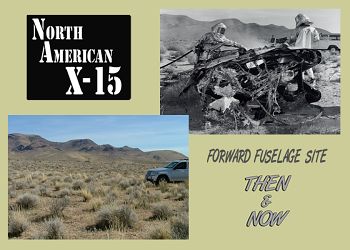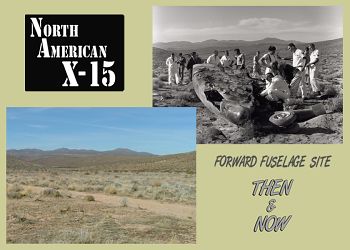Search for the X-15
"Let's look for the X-15," said Tony Moore. Pete Merlin was silent for a moment and then a smile came over his face. "That's a great idea," he replied. And, so it began.
They knew the key was research. More information now meant less time wasted in the field later. Pete and Tony had learned valuable lessons from previous solo searches for the YB-49 and XB-70. Now they teamed up and pooled their talents.
On 26 June 1992 they drove to Edwards Air Force Base to visit the Air Force Flight Test Center History Office. They examined numerous documents for historical information about the X-15 and the accident. Pete and Tony continued to pore through the archives during two more visits in July.
After finding a set of geographic coordinates in a report and a photograph in a book by X-15 pilot Milt Thompson, they felt confident enough to head out into the field.
On 11 July, they drove to the Red Mountain district and began to search the area defined by the coordinates. It soon became apparent that they were in the wrong area. The coordinates proved highly inaccurate. Frustrations mounted.
Pete and Tony were about ready to give up. They got back into the Jeep and began to drive away. Suddenly they spotted a familiar landmark from the photo. Pete parked the Jeep and picked up Thompson's X-15 book. Turning to the proper page, he lined up the photo with the horizon. They were very close.
Pete and Tony began to walk across the desert, studying the photo at intervals. Pete walked ahead and then stopped. He looked at the picture, took a few steps and stopped again. Tony watched him as he looked at the horizon, then the photo. Pete then closed the book, bent over and picked up a piece of metal tubing. "We're here," he said.
Within minutes they had positively identified the X-15 crash site. The terrain matched the photo perfectly. There were numerous pieces of metal and plastic, obviously aircraft components, on the ground. The metal fragments included pieces of titanium and inconel (a nickel alloy used extensively in the X-15).
A careful search revealed artifacts that further confirmed the identity of the site. The MASTER warning light, and placards unique to the MH-96 computer console, were indisputable evidence that this debris was part of the third X-15.
In 1993 Tony contacted Milt Thompson at the NASA Dryden Flight Research Center and asked him about the X-15 accident. Thompson shared his recollections and provided Tony with a map of the debris field. This set the stage for the second phase of the hunt.
Pete and Tony spent the next two years combing the debris field during seven expeditions. They found more than 50 pieces totaling over 125 pounds. Some of the more spectacular finds included various access panels, part of a wing with a reaction control system (RCS) thruster, parts of both sides of the upper vertical tail with remnants of the numbers "72", and most of the right flap (in several pieces). An X-15 data plate was attached to the inboard edge of the flap.
The most massive find was a 35-pound piece of the left horizontal stabilizer. This piece and several others (including the tail number) were donated to the Air Force Flight Test Center Museum at Edwards.
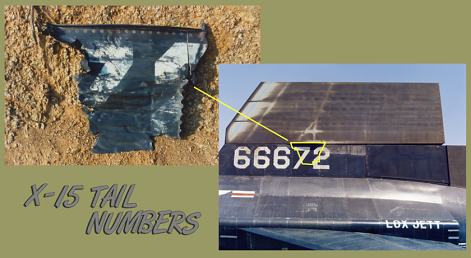
X-15 TAIL NUMBER FRAGMENT THIS PIECE OF THE UPPER VERTICAL STABILIZER BEARS PART OF A FADED WHITE "72", REMNANTS OF THE X-15's LAST TWO TAIL NUMBERS, SHOWN OUTLINED IN A PHOTO OF THE COMPLETE RUDDER AND STABILIZER ON THE RIGHT. THE FRAGMENT WAS CREATED AS THE RUDDER TORE ITSELF LOOSE FROM THE AIRCRAFT AS IT BROKE UP HIGH ABOVE THE MOJAVE DESERT
THIS ARTIFACT IS NOW PART OF THE AIR FORCE FLIGHT TEST CENTER MUSEUM COLLECTION |
|

X-15 SPHERICAL TANK STRAP THIS TITANIUM STRAP WAS USED TO SECURE A SPHERICAL TANK OF HELIUM, WHICH WAS SIMILAR TO THE TURBOPUMP FUEL TANK PICTURED ABOVE. THE HELIUM WAS USED TO PURGE OTHER GASES FROM THE XLR-99 ROCKET ENGINE. CIRCLED IS ONE OF THE THREE ADJUSTABLE FASTENERS THAT JOINED THE STRAP TOGETHER
|
|
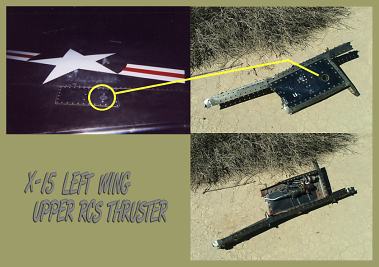
X-15 RCS THRUSTER THE PHOTOS ON THE RIGHT SHOW A TOP AND BOTTOM VIEW OF ONE OF THE X-15's REACTION CONTROL SYSTEM THRUSTERS THAT WERE USED TO CONTROL THE VEHICLE WHILE IN THE VACUMM OF SPACE. THIS ONE, ONCE MOUNTED IN THE UPPER SIDE OF THE LEFT WING IS IDENTICAL TO THE ONE IN THE PHOTO OF THE #2 X-15's WING SHOWN ABOVE. THE THRUSTER ASSEMBLY IS STILL ATTACHED TO A SECTION OF THE WING'S STRUCTURE AND, IF YOU LOOK CLOSELY, REMNANTS OF THE WHITE "BEWARE OF BLAST" WARNING PLACARD CAN BE STILL BE SEEN NEXT TO THE THRUSTER'S NOZZLE |
|
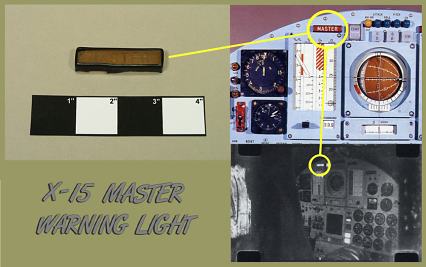
X-15 MASTER WARNING LIGHT THIS MASTER WARNING LIGHT WAS LOCATED ON THE UPPER LEFT SIDE OF THE #3 X-15's MAIN INSTRUMENT PANEL (CIRCLED IN THE UPPER RIGHT PHOTO). THE LIGHT ALERTED THE PILOT TO ANY CRITICAL FLIGHT SYSTEM PROBLEMS AND CAN BE CLEARLY SEEN ILLUMINATED IN ONE OF THE LAST FRAMES OF THE COCKPIT CAMERA'S FINAL FOOTAGE. (CIRCLED IN THE LOWER RIGHT PHOTO)
|
|
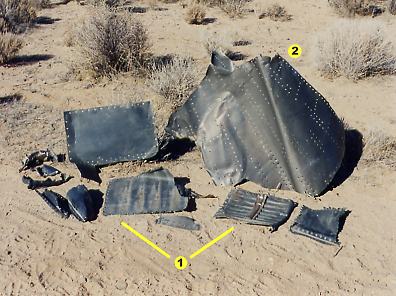
X-15 FUSELAGE PIECES 1. VARIOUS AIRCRAFT PANELS AND DEBRIS BLOWN OFF THE FUSELAGE AS IT BROKE UP
2. LARGE SECTION OF INCONEL-X WING SKIN RIDDLED WITH HOLES CREATED WHEN IT WAS TORN AWAY FROM THE RIVETS HOLDING IT TO THE WING'S STRUCTURE AT SPEEDS IN EXCESS OF 2,000 MPH
|
|

X-15 HORIZONTAL STABILIZER SECTION THIS IS THE FORWARD CENTER SECTION OF THE X-15's RIGHT HORIZONTAL STABILIZER. ITS IMPACT WITH THE GROUND FLATTENED ONE SIDE LEAVING IT STANDING IN THE DESERT, LEADING EDGE POINTED TO THE SKY, JUST AS WE FOUND IT.
THIS ARTIFACT IS NOW PART OF THE AIR FORCE FLIGHT TEST CENTER MUSEUM COLLECTION |
|

X-15 AIRCRAFT DATA PLATE CLOSE UP OF AN AIRCRAFT DATA PLATE ATTACHED TO WHAT WAS ONCE THE INNERMOST STRUCTURAL EDGE OF THE RIGHT WING FLAP. ON IT CAN BE SEEN THE DESIGNATION "X-15", THE AIRCRAFT'S PART NUMBER AND A NORTH AMERICAN AIRCRAFT INSPECTION STAMP THAT MADE THIS ARTIFACTS IDENTIFICATION RATHER EASY |
|
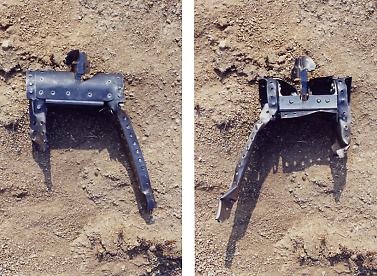
X-15 FLAP HINGE FRONT AND REAR VIEW OF A TITANIUM FLAP ATTACHMENT HINGE THAT WAS TWISTED AWAY FROM THE X-15's WING AS THE FLAP WAS TORN APART AT SPEEDS IN EXCESS OF 2,000 MPH
|
|
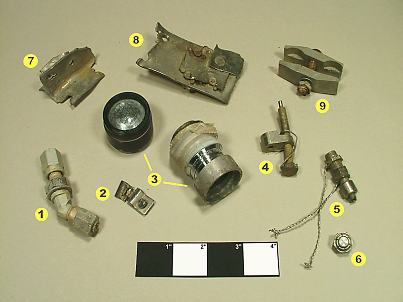
X-15 ENGINE SECTION PARTS THESE ARTIFACTS WERE RECOVERED FROM THE ENGINE SECTION SITE
1. SMALL AIRCRAFT ENGINE FITTING 2. SMALL HINGE 3. LENS PIECES FROM REAR FACING 16MM CAMERA. THE CAMERA WAS LOCATED BELOW THE UPPER SPEED BRAKES AT THE BASE OF THE VERTICAL STABILIZER 4. ADJUSTING BOLT, STILL SAFTEY WIRED 5. SMALL AIRCRAFT FITTING, STILL SAFETY WIRED 6. HIGH STRENGHT AIRCRAFT FASTENER SHEARED OFF WITH BOLT END 7. AIRCRAFT INTERNAL STRUCTURE 8. AIRCRAFT INTERNAL STRUCTURE WITH SMALL FRAGMENT OF INCONEL-X AIRCRAFT SKIN ATTACHED 9. TUBING CLAMP
|
|

X-15 COCKPIT PARTS THESE ARTIFACTS WERE RECOVERED FROM THE FORWARD FUSELAGE SITE
1. FRAGMENTS OF THE "BALLISTIC CONTROL STICK" GRIP. THIS WAS USED TO OPERATE THE REACTION CONTROL SYSTEM WING AND NOSE THRUSTERS THAT STEERED THE VEHICLE DURING ITS BREIF SPACE FLIGHT 2. CAUTION/WARNING LIGHT FRAME 3. ELECTRONICS PLACARD 4. INSTRUMENT KNOB AND INSTRUMENT FASTENER 5. INSTRUMENT GAUGE NEEDLE (FROM ONE OF SEVERAL PRESSURE INDICATORS ON LOWER RIGHT INSTRUMENT PANEL) 6. MH-96 SYSTEM CONTROL PANEL PLACARD FRAGMENTS 7. INSTRUMENT CASE FRAGMENT 8.FRAGMENTS OF THE ALTERNATE TRIM SWITCH. THIS SWITCH WAS LOCATED ON THE PILOTS STICK GRIP AND WAS USED TO TRIM THE AIRCRAFT IN FLIGHT |
|
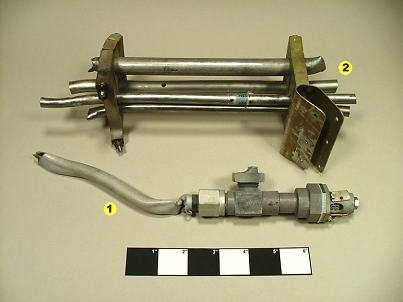
X-15 PIPE BUNDLE & VALVE 1. AIRCRAFT NITROGEN SYSTEM PRESSURE RELIEF VALVE
2. TUBING BUNDLE AND GUIDES. NOTE PARTIAL HYDROGEN PEROXIDE IDENTIFICATION LABEL ON FOREMOST TUBE. |
|
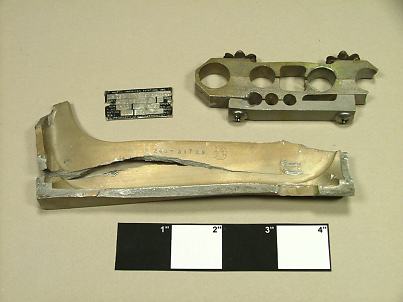
X-15 PART NUMBERS & INSPECTION STAMPS SEVERAL PARTS SHOWING NORTH AMERICAN AVIATION MANUFACTURER INSPECTION STAMPS AND PART NUMERS. THESE ARE USED TO CONFRIM THE AIRCRAFT'S IDENTIFICATION |
|
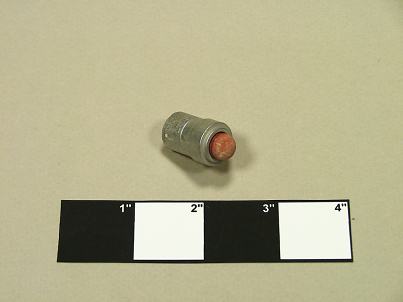
X-15 PILOTS MIC SWITCH THIS MICROPHONE SWITCH WAS LOCATED ON THE X-15's STICK GRIP. THUMB ACCUATED, IT WAS USED BY THE PILOT TO COMMUNICATE |

© Copyright 2004-, The X-Hunters. All rights reserved. Copyright Policy Privacy Policy Page last modified 05/01/2023
